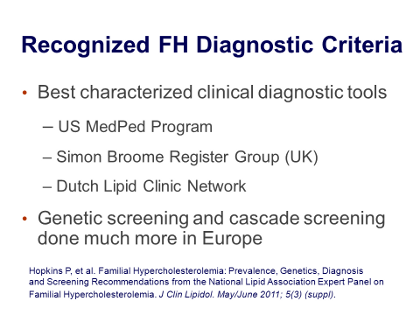Goldberg - Figure 3 - FH diagnostic criteria Text
As shown in this Figure, there are recognized FH diagnostic criteria. The best characterized clinical diagnosed tools come from the US MEDPED (Make Early Diagnosis to Prevent Early Deaths) program,[1] the Simon Broome Register Group[2] from the United Kingdom, and the Dutch Lipid Clinic Network.[3] Genetic screening and cascade screening are both done much more in Europe than are currently being done in the United States. In the United States, screening for FH usually involves
- assessment of blood cholesterol concentrations
- inspection for physical signs of FH, such as xanthomas
- evaluation of family history.
References
[1]US MedPed program. www.medped.org.medped.org
[2]Simon Broome Register Group. Risk of fatal coronary heart disease in familial hypercholesterolaemia. BMJ 1991;303:893-896.
[3]Versmissen J, Oosterveer DM, Yazdanpanah M, et al. Efficacy of statins in familial hypercholesterolaemia: A long-term cohort study. BMJ 2008; 337: a2423.
[4]Newson, A. J., Humphries, S. E. Cascade testing in familial hypercholesterolaemia: how should family members be contacted? Europ. J. Hum. Genet. 13: 401-408, 2005.
